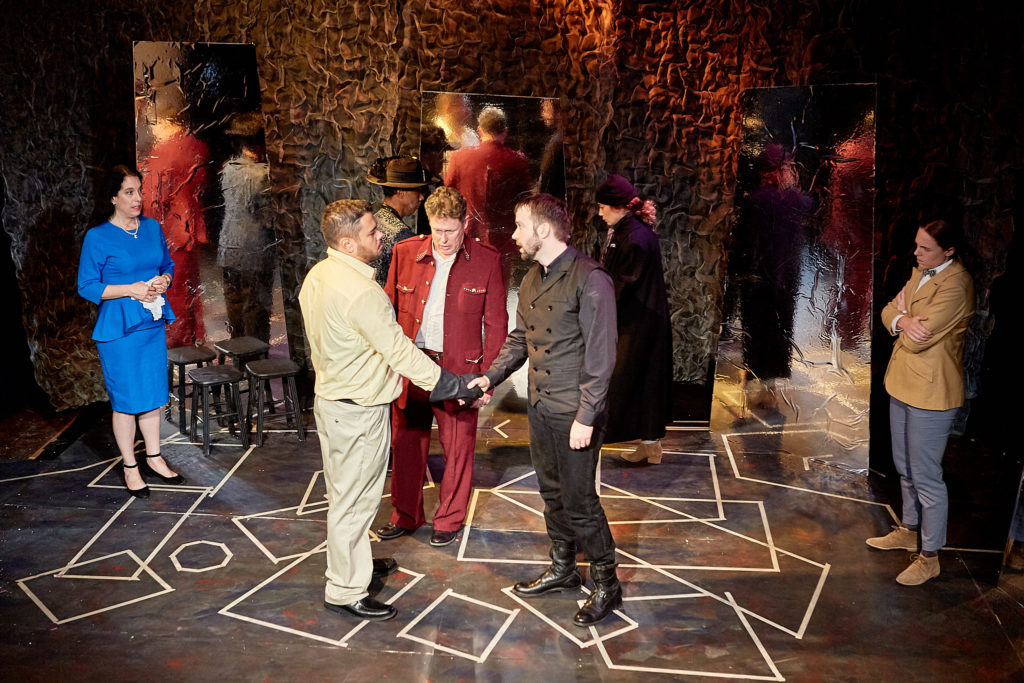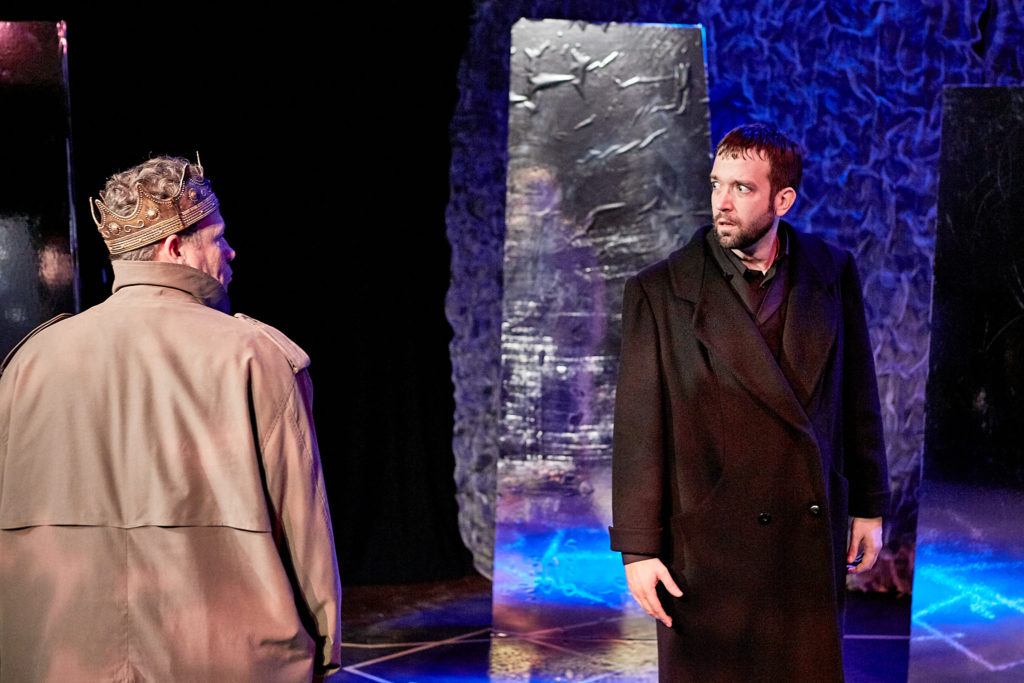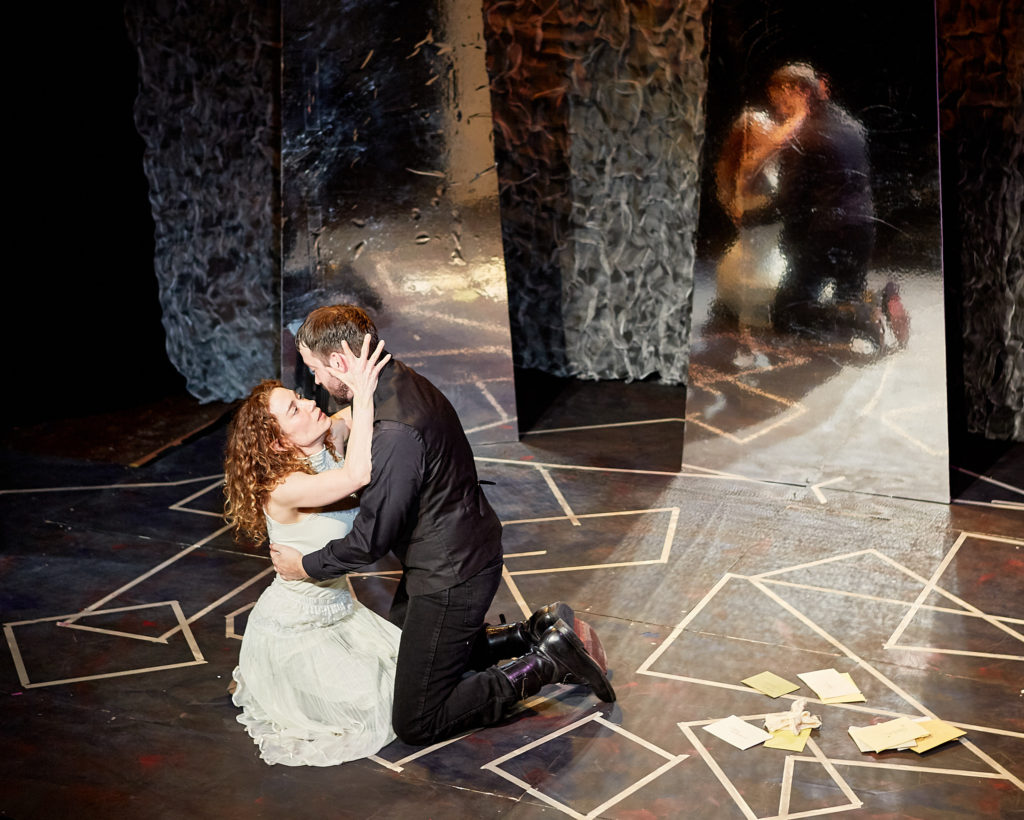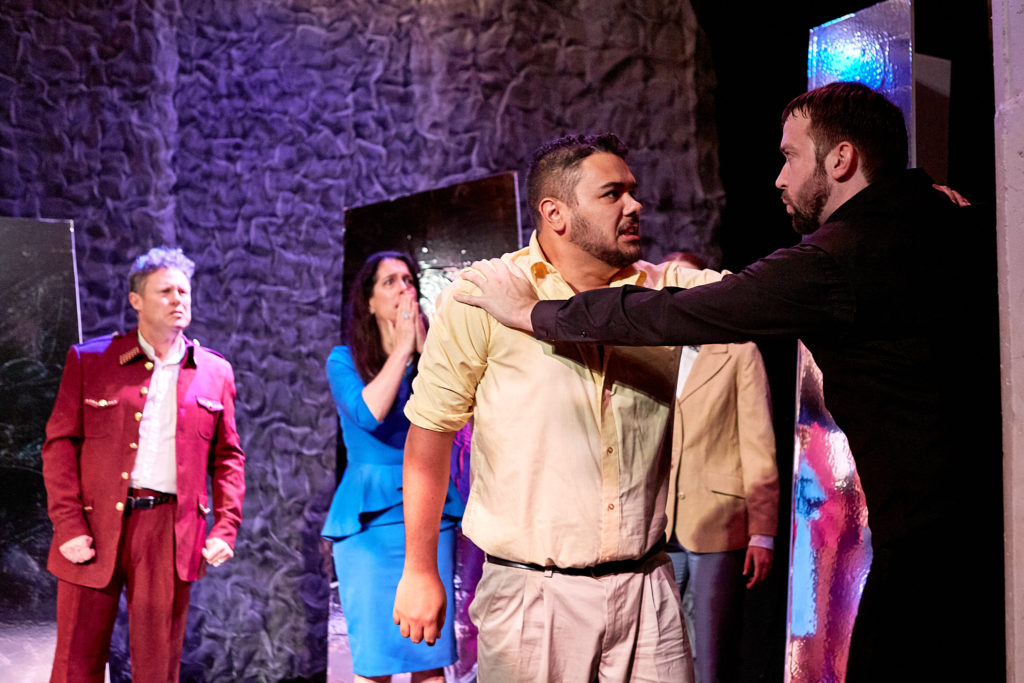A Tale of Two Hamlets: A review of the Arabian Shakespeare Festival Production.
November 5, 2017 § Leave a Comment
At the center of the Arabian Shakespeare Festival’s current production of Hamlet are exceptionally insightful and original performances by William J. Brown III as the title character and Nathaniel Andalis as his bête noir and foil, Laertes. Without directly saying so, the production sidelines the more conventional antagonist, Claudius, with all-too-relevant implications.

The cast of Hamlet, with Nathaniel Andalis as Laertes and William J. Brown III as Hamlet in the Foreground, John Flanagan as Claudius between them and Rachel Bakker as Gertrude, Norman Gee as Osric, Emily Keyishian as a courtier and Kate Rose Reynolds as Horatio looking on.
Hyperion to a Satyr
Of course, no play is thought to be so “universal” as Hamlet, so it is no surprise that any reading seems somehow current. Nonetheless, a focus on Hamlet’s disgust at the weakness of the current leader in comparison to his immediate predecessor, and his incredulity that anyone (let alone everyone) fails to see it, is so pregnant with contemporary implications that the production positively boils with renewed urgency.
John Flanagan plays Claudius as a weak and self-important ruler, so it is instantly believable when the play reveals he sleazed (rather than powered) his way into the job. Hamlet is too well-known for Claudius’ guilt to surprise anyone, but in this case, the production dwells on the patient investigation necessary to bring it into the open. Something IS rotten in Denmark, and everyone knows it, but out of pure self-interest no one will be the first to say so.

William J. Brown III as Hamlet, with John Flanagan as the Ghost. Photos by Gregg Le Blanc.
O Cursèd Spite!
Brown’s Hamlet is the opposite of the traditional conflicted and dithering naïf. This Hamlet is on the edge of rage from beginning to end. He has to fight for control of his passions, and struggles to apply the rationality he knows the situation demands if he wants justice and not just revenge. Brown is an exceptionally intelligent actor. His delivery of Hamlet’s famous soliloquies is slow and meticulous, but only because his Hamlet is so obviously forcing himself to reason through circumstances where he would rather rampage.
In this production the most powerful counter-force is Laertes who, like Hamlet, is another seeker of revenge for his father’s murder. Interestingly, the actor in this role is Nathaniel Andalis, who spent his summer playing the title role for the San Francisco Shakespeare Festival. Andalis is a charismatic performer with exceptionally deep connections to this play. (His bio says that he hopes to play all the roles in the play eventually, and in this production he is half-way to meeting this goal by notching up his seventeen role in the show.) Laertes exists in the show as a “foil,” a subsidiary character whose situation mirrors that the protagonist so that we might see both comparisons and contrasts. I’ve never seen this function so fully executed as it is in the performance Andalis delivers. I attribute this to the fact that he so deeply understands exactly how the role illuminates that of Hamlet, emotionally and thematically, because he brings such deep perception of the title role from his own experience of playing it. In a way, in this production you get to see two Hamlets – and they are both compelling. Placed in opposition to each other, they are explosive.
The company was rounded out by Rachel Bakker as Gertrude, Norman Gee as Polonius, Emily Keyishian as Ophelia, and Kate Rose Reynolds as Horatio. (All four also played several other parts.)

Brown as Hamlet with Emily Keyishian as Ophelia on Malcolm Rodgers reflective set.
A Great Reckoning in a Small Room
I am on record as a big fan of this small but interesting company. A couple of years ago they produced an Othello that thoroughly explored the title character as an Arabian Moor that opened completely new aspects of the play for me. Both pre-show publicity and program notes suggest that this Hamlet is also filtered through an Arabian viewpoint – although I do not think this displays overtly or that this information is necessary to appreciating their effort. The play, in fact, seems particularly relevant and compelling for reasons (outlined above) that seem far from the Arabian traditions of political revenge tales that it might be referencing. The obvious political implications as well as the preciseness of the investigation of revengers (in this case doubled because the Laertes is rendered as specifically as the Hamlet) is what makes this production unique.
The production is staged by Kevin Hammond, whose work tends to emphasize striking individual moments that don’t always cohere into a big picture. Some of those moments, however, (especially Hamlet’s encounter with Claudius at prayer) are stunningly effective and thought-provoking. Hammond’s greatest contribution was the dramaturgy of the production: The text was both abridged and intriguingly rearranged (into almost collage fashion).
Malcom Rodgers’ minimalist, mirror-laden set was evocative. Matt Stines’ sound design was subtle but brilliant. Patricia Tyler’s costumes, by contrast, were pedestrian and insistently realistic in a production that was otherwise built on theatrical convention. (The production is performed by seven actors jumping quickly in and out of multiple roles.)
The highlight of the night was the exceptional fencing match-turned-duel at the end of the play, choreographed by Andrew Joseph Perez. The fact that we were right on top of it in the tiny (40 seat) Royce Gallery contributed to the sense of danger, but such immediacy worked in the play’s favor here, and throughout the show.

Nathaniel Andalis as Laertes and William J. Brown III as Hamlet (with cast members looking on)
Hamlet has a limited run, and there are few seats. If you love this play, this is an interpretation you don’t want to miss, with two stellar performances that you shouldn’t miss. See it while you can.
This article has been updated to credit director Kevin Hammond with the dramaturgy, and to include additional photos.
This review is of the Nov. 3 performance.
More Information
Hamlet plays through November 19th
(Thursdays- Saturdays at 8pm & Sundays at 2pm)
Royce Gallery (2901 Mariposa St., San Francisco, CA 94110).
Visit www.arabianshakes.org for tickets and more information.
Minimalist Tragedy: MACBETH at the Arabian Shakespeare Festival
October 2, 2016 § Leave a Comment
Teddy Spencer is a San Francisco-based actor with a Benedict Cumberbatch-ish look and appeal. He is tall and lanky, possessed of a warm baritone and radiating intelligence. He can be hilariously self-effacing, even goofy, when performing comedy but he is also a formidable tragedian. I first saw him as Orlando in As You Like It at the Marin Shakespeare Company, but it was after seeing him as a steely Iago in Othello with the Arabian Shakespeare Festival that I became a genuine fan. Now he has returned to the latter company as Macbeth in a production that places the focus squarely on him, and he is hypnotic.

Teddy Spencer and Radhika Rao as the Macbeths. Photo by Gregg Le Blanc.
The Arabian Shakespeare Festival is an emerging company under the artistic direction of William J. Brown III. Their mission is to use theatre as a cultural bridge between the Middle East and the West. (Their current production is heavily supported by a sizeable gift from The People of Kuwait.) I was enormously impressed by the previously-mentioned production of Othello, which explored the tensions of assimilating Arabs by taking seriously the Elizabethan connotation of “Moor” to imply someone of middle eastern origin. It was timely and thought provoking.
Their Macbeth is less conceptually related to their mission, as it does not directly imply an Arabian connection despite a passing reference to the Arab Spring in the director’s notes, but that is possibly because any play about an obsessively ambitious strong man coming to power inevitably has more immediate connotations during this frightening election season. The evening’s virtues are quite different from those of the last time I saw this company.
The Real Curse
There is a rich folklore about the cursed nature of the play, but real theatrical insiders will tell you that the main way that it is blighted is that it reads much better than it stages. Despite the high esteem in which the playtext is held, surprisingly few productions of the play come off well. To modern audiences the supernatural element is often silly instead of frightening. Bucket loads of stage blood can, and usually do, become unintentionally hilarious. Relentless misogynistic interpretations of Lady Macbeth often sink the enterprise before it really launches. The reader can find it spooky without “jumping the shark” in their own mind’s eye, but it is downright difficult to make the play work when it has to be materially realized. In performance, it is best to leave a lot to the imagination.
There are some deep textual complexities that cause a lot of issues with producing the show. The only text of the play we have is from the 1623 First Folio of Shakespeare’s work, but scholars have clearly established that that version contains material inserted from a much later play, The Witch by Thomas Middleton, and that Middleton is probably also responsible for heavily cutting and arranging the original text into a streamlined performance text. (Shakespeare could not have inserted the material himself, because Middleton’s play was not written before he died, and therefore probably did not cut it himself either.) The version we have is full of plot holes and contradictions, with an uneven pace. The action flies by in the first half and then grinds to a slog in the second. Lady Macbeth is a powerful presence in the beginning but fades into the background once she becomes queen. Character development in the minor roles is truncated, and sometimes just confusing. It takes some very intensive dramaturgy to keep the play on track.
Keep It Simple, Stupid
Director Terri McMahon avoids many of the most deadly traps by keeping things very simple. A cast of six, performing on a virtually empty set, with minimal props, no fake blood, and evocative contemporary costume bits and pieces performs the show in a drastically cut, fast moving, version of the play. The staging is clean and efficient, with a few moments of clever theatricality. The direction is enhanced by two striking ideas: Nathaniel Andalis, who plays Banquo, continues in a highly original extension of that role to appear onstage after his murder not only as the ghost at the banquet, but also as the visions conjured by the witches, then as the embodied curses and ultimately as a physically manifest malevolent supernatural force intervening against Macbeth. It was both unfussy and theatrically effective. McMahon also chose to place Lady Macbeth’s death (which in only reported in the text) fully onstage and left her body downstage center while the final duel played out. Radhika Rao avoids the clichés in her portrayal of Lady M, and is moving in her later scenes, especially in this interpolated death scene, but the production’s focus is elsewhere.

Nathaniel Andalis as Banquo, Nicole Weber as Fleance, and William J. Brown as Duncan
Actors William J. Brown III, Kirsten Peacock and Nicole Weber do some heavy lifting by rapidly shifting between multiple characters – playing something like half a dozen each. (In a fine show of virtuosity Peacock plays both Macduff and Lady Macduff in the production, both compellingly.) The performance space at the Royce Gallery is tiny, and in combination with the small cast and shortened play, there is little spectacle. Battle scenes and other parts of the play usually populated by crowds are stripped away almost to nothing. Most of what powers a typical production forward is absent from this one altogether.
All that is sacrificed produces one overwhelming and original insight into the play, and makes it riveting. In this minimal staging, we realize that a great deal of the play is surprisingly intimate, and blossoms in this unforced simplicity. Lady Macduff has a touchingly domestic scene with her doomed son. Banquo teases and teaches his son, Fleance, in an almost casual fatherly moment of calm amidst the crisis. The Macbeths agonize over whether to move forward huddled together in a tiny hallway. In stark contrast to the histrionics usually employed, this production favors small, introverted moments.
In this tightly-focused, sometimes suffocating, atmosphere Spencer performs a beautiful miracle. He pulls us into Macbeth’s soliloquies with such unwavering intensity that we actually root for this man. His performance is so contained it feels almost private, but his voice and face are so expressive it is like constantly watching him in cinematic close-up. He seductively whispers his innermost fears, dreams and delusions to us until we feel we have direct access to his damaged (and ultimately damned) soul.
This is not a performance built on charisma and starpower, although Spencer has plenty of both. It is just an actor with enormous courage letting us into his unguarded and unfiltered core. Of the many productions I have seen, this is the first time I have felt that I truly understood the human tragedy of a man who lost himself. In a very Hamlet-ish performance, Spencer fully realizes the protagonist reaching for his destiny, dancing with madness, and ultimately facing death squarely.
It is a small company with a brief run, that deserves your support and attention. Treat yourself and go see this performance.
Production information, per the Festival’s publicity poster:

Seen Sept. 30, 2106.
The Mask of Blackness: The Arabian Shakespeare Festival’s OTHELLO reexamines Moorishness.
November 15, 2014 § 2 Comments
Otherness comes in many flavors
Since the extinction of the practice of white actors performing (and stereotyping) the title role of Othello in blackface, the play – at least in America – has featured actors of color and become a vehicle for examining black/white race relations. Because that is a necessary, and still unresolved, conversation it has been a highly successful strategy for rediscovering the relevance of the play.
What got lost in that transition is the possibility that Shakespeare was dramatizing otherness and ethnicity, but from a different perspective than Americans are imposing on it because of our current cultural complications: Othello is identified as a Moor, a word more closely associated in the Elizabethan era with those of Arabian descent than with peoples from sub-Saharan Africa. At about the time Shakespeare was writing the play, in fact, Elizabeth was receiving a famous embassy from the Barbary States. The ambassador, who manners and dress captivated London, took time to have his portrait painted.

Abd el-Ouahed ben Messaoud ben Mohammed Anoun (Arabic: عبد الواحد بن مسعود بن محمد عنون) was principal secretary to the Moroccan ruler Mulay Ahmad al-Mansur, and ambassador to the court of Queen Elizabeth I of England
The San Francisco-based Arabian Shakespeare Festival is now producing the play in a version which, unsurprisingly given its mission, opens the conversation about the Anglo/Arab implications of the play. The eight-person cast, led by Armando McClain, is mostly composed of accomplished regulars with various troupes in the active Bay Area Shakespeare scene.
The company is an emerging group, still producing on a shoe-string – albeit in an Equity approved project. Performing currently in the Royce Gallery’s intimate space, (the production will later tour to the United Arab Emerates, I think) the set is a modern adaptation of an Elizabethan open stage, cleverly incorporating two large support pillars into the downstage location similarly occupied in the Globe. The scenery, by Janny Cote, consists of a few sliding cubes and a couple of curtains. (These were hung from an incongruously omnipresent palm-ish tree, center stage, which may allude to the symbol of the desert tribes, but because it lacked any direct purpose was – at least to me – confusing.) Joanne Martin’s costumes were suits and uniforms for the male characters, dresses with prominently featured head scarves for the women. The time and place was the modern Middle East.
Performing in an American/Arabian Context
Kevin Hammond’s direction is understated, and as far as creating visually interesting groupings of the actors, essentially absent. The production, therefore, hangs on the performance of the actors, and on the inescapable contemporary implications arising from the company’s American/Arabian context.
On the performance front, the production is an unmitigated treat. In almost any production McClain’s beautiful vocal production and outstanding diction would stand out, but Teddy Spencer as Iago, Jennifer Le Blanc as Desdemona and Artistic Director William J. Brown III as Roderigo easily kept pace. This was far and away the best-spoken production I have recently experienced. For those who go to hear a Shakespeare play, this is what you dream about. The intelligence of the readings, the clarity of thought, and the easy audibility made this production as accessible as any contemporary play. There was never a moment I felt in doubt about what had been said or what was meant.
Spencer’s Iago is especially rewarding. He is a meticulous actor. I previously admired his performance as Orlando in Marin Shakespeare’s As You Like It for its extraordinary clarity, but his Iago is on another plane altogether. The steps by which his plot unfolds, exceeding even his expectations, are so carefully executed that you can feel him thinking in front of you. His Iago is colder than is currently fashionable, which is interesting in the context of Red State America’s xenophobia – he feels no need to seduce us into agreeing with him. Although Spencer is capable of incredible charisma on stage, he does not seek to charm us in this role. Instead, he steadily implicates us in his plot with an expectation that we will share his hatred of the outsider – which is chilling.
Le Blanc is very well known in the Bay Area. Her Rosie-the-riveter-inspired Kate in Taming of the Shrew at Livermore Shakes (opposite McClain as Petruchio) was a powerhouse performance. She is an unusual Desdemona because she is anything but delicate, or helpless. She is a strong actress, and it infuses her characters. Her Desdemona’s fate forces us to think about the issues of women’s rights both domestically and internationally because she is not passively complicit in it. She fights right to the end.
Perhaps the single best performance in the play is Brown’s wonderfully inept Roderigo, whom Iago dupes financially and ultimately murders. From the opening moments he is in over his head, but Brown’s embodiment of his bewilderment, fear, and pliability is a tour de force. It is exceptionally difficult to play weak characters memorably, but Brown’s Roderigo is the best I have ever seen.
Annamarie MacLeod rounds out the principals as Emilia, Desdemona’s servant and Iago’s estranged wife. Emilia has one of the most memorable monologues in Shakespeare, rationalizing why women might cheat on their cheating husbands, but MacLeod delivered it with a vulnerability and yearning for her lost husband that I have never previously seen.
The supporting cast included Malcolm Rodgers, Aaron Kitchin and Sofia Ahmad all of whom had some lovely moments.
A Fresh Context
Conceptually this is not an aggressive production. While the play itself focuses attention on Othello’s outsider status, the implications of the Arabian context in our current climate (where Arab-Americans can be subjected to intense hostility no matter what their religious beliefs or degree of assimilation) unfold subtly and slowly. I, at least, have seen the play so often filtered through the lens of the African-American experience that it took a while to realize exactly how this production was filtered through the American-Arabian lens instead. (There is neither denigration or dismissal of the former in this production, it is simply seen – unusually for our time – through the latter.)
Nonetheless, it gives the play a different feel and focus. For example, near the end of the play Othello receives word that he has been reposted, creating an urgency in his mind to deal with his (in his belief) unfaithful wife before the opportunity passes him by. He might have dealt with things more slowly and rationally if he were not being transferred the next day. And to where? I never really paid attention before, that his transfer is to Mauritania, from which the word for his ethnicity, Moor, is derived. Venice is rewarding his outstanding service by exiling him to a remote outpost where he will “fit in” now that they no longer need him.
Or this: Desdemona introduces the prophetic “willow song” by telling us that her mother’s maid sang it on the night she died. The maid’s name was Barbary – she was Moorish from the Barbary Coast. The number of references to Arabian matters and frameworks is astonishingly high once they are highlighted by design or by context.
Of course, throughout the play many characters (including Othello, himself) also comment on his blackness. This can be understood symbolically, but it has been a long time since I saw an Othello who was not also very dark skinned, so I have hear these references literally instead. (The last Othello I saw who was not very dark skinned was probably Patrick Stewart in a famous “photo-reversed” production for the Shakespeare Theatre in Washington, D.C. in the mid ’90s where everyone else in the cast was African-American.)
I have no idea how Armando McClain self-identifies ethnically, (nor do I think he – or any actor – has any obligation to clarify such matters) but in this production he reads more bronze than black. In this case, that helped me to hear the production as emphasizing the metaphor, the “mask” if you will, of blackness instead of the literalness so often associated with Othello’s and others’ statements. It was useful and interesting to think freshly about the association of darkness with malignancy and the damage done by such connotations.
This is a fascinating and original production of a play which has grown somewhat interpretively stale in the repertoire, and worth the time and effort of anyone that wants to see and hear it with fresh appreciation. It has a short run, and a limited number of seats, so go while the opportunity is available!
Othello
Arabian Shakespeare Festival at the Royce Gallery
Nov. 14, 2014
www.arabianshakespearefestival.org

